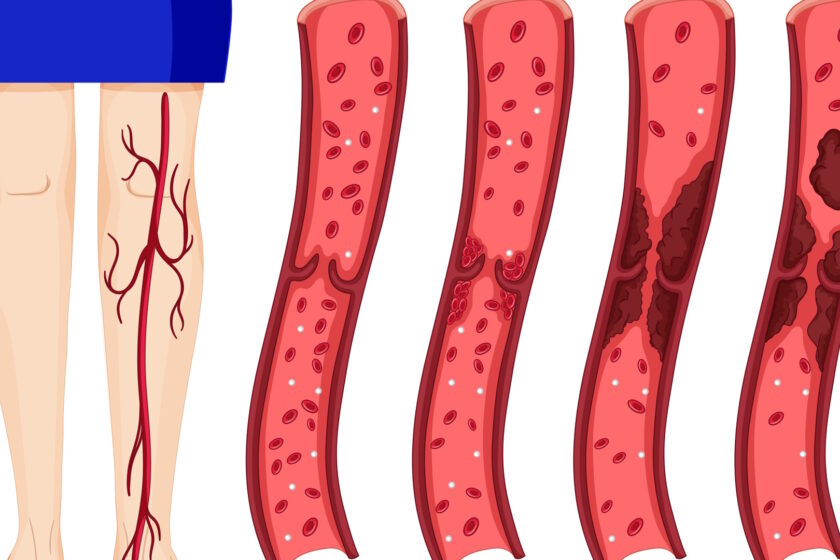
5 Early Signs & Symptoms of Deep Vein Thrombosis (DVT)
As a distinguished and dedicated vascular surgeon with several years of enriching experience, Dr. Sumit Kapadia has devoted his professional life to understanding, diagnosing, and treating a wide range of vascular diseases. His deep understanding and extensive expertise, gained from treating over 15,000 patients in Vadodara and Surat, have enabled him to share a wealth of knowledge with patients and the general public. In this blog post, he shares his insights on an important vascular condition that is often misunderstood – Deep Vein Thrombosis (DVT). This article aims to shed light on the early signs and symptoms of DVT, highlighting when it is critical to seek medical attention, and offering practical and effective prevention tips. His primary objective with this blog is to empower you with knowledge about DVT so that you can take early and effective action if needed, thereby ensuring the best possible health outcomes.
Overview of Deep Vein Thrombosis (DVT)
Deep Vein Thrombosis (DVT), a serious medical condition affecting the circulatory system, occurs when a blood clot, or thrombus, forms in the deep veins of the body, typically in the legs. If left untreated, DVT can cause severe complications, like a pulmonary embolism, a life-threatening condition when a blood clot dislodges and travels to the lungs.
Although DVT can affect anyone, it is more prevalent among individuals with prolonged immobility, those with certain genetic clotting disorders, and those who are obese or smoke. DVT is a different condition from varicose veins, though both affect the veins in the legs. While varicose veins are typically a superficial vein issue causing bulging, twisted veins near the skin’s surface, DVT affects deeper veins and poses greater health risks.
Dr Sumit Kapadia, a leading vascular surgeon practising in Vadodara and Surat, Gujarat, India, has expertise in diagnosing and treating a wide range of vascular conditions, including DVT.
5 Early Signs of Deep Vein Thrombosis
Recognising the early symptoms of DVT can potentially save a life by ensuring prompt and effective treatment. Here are the common signs of DVT in more detail:
Swelling
Swelling in the leg is one of the primary early-stage DVT symptoms. This can occur in one or both legs but is commonly seen in just one. It happens because the blood clot obstructs the flow of blood, causing it to accumulate in the leg.
Pain and Tenderness
Pain associated with DVT often starts in the calf and might feel like cramping or soreness. It’s similar to the feeling you get after a vigorous workout or when you’ve been standing for a long time. However, the discomfort linked with DVT doesn’t go away with rest and may worsen when you stand or walk.
Warmth
If you notice an area of your leg feeling warmer than the surrounding skin, it could be a sign of DVT. The inflammation caused by the blood clot leads to a local increase in temperature.
Skin Discoloration
The skin over the blood clot may change colour, turning pale, red, or even blue. This discolouration is due to the decreased oxygen supply to the affected area because of the obstructed blood flow.
Leg Fatigue
A constant feeling of tiredness or heaviness in the leg can be a symptom of DVT. This fatigue doesn’t go away with rest and might worsen throughout the day due to blood accumulation in the leg.
These symptoms can vary from person to person and might be mild in the initial stages, making them easy to overlook or mistake for less severe conditions like muscle strain. However, if you notice these signs, particularly if they appear suddenly and persist, seek immediate medical attention.
Remember, DVT is a serious medical condition and warrants urgent care. Timely consultation with an experienced vascular surgeon like Dr Sumit Kapadia could potentially save your life and prevent severe complications.
When to Seek Medical Attention
Deep Vein Thrombosis is a serious condition that requires immediate medical attention. If you are experiencing any of the symptoms outlined above, you should seek medical help without delay. DVT can lead to severe complications, like a pulmonary embolism, a potentially fatal condition where a blood clot in your vein breaks free, travels through your bloodstream and blocks the blood supply to your lungs.
Here are the specific signs indicating an immediate need for medical help:
Severe Leg Pain
If the pain in your leg is unbearable, worsening over time, and not alleviated by rest or over-the-counter pain relievers, it’s time to consult a healthcare professional. Rarely, acute arterial blockages can also lead to swelling and may be misdiagnosed as DVT. A timely evaluation by a seasoned vascular surgeon would be very valuable.
Intensified Symptoms
A sudden increase in swelling, redness, and warmth over the affected area may indicate a worsening condition and requires immediate medical evaluation.
Difficulty Breathing
Experiencing breathlessness, chest pain, or discomfort that worsens with deep breathing or coughing can be symptoms of a pulmonary embolism. This is a medical emergency and requires immediate attention.
Syncope or fainting
This can also be a sign of a pulmonary embolism. Any episode of unexplained fainting should prompt an immediate medical consultation and admission to a dedicated intensive care unit.
Whenever you suspect DVT, a visit to a reputed vascular surgeon like Dr. Sumit Kapadia would be the ideal course of action. His vast experience in treating vascular diseases will ensure you receive the most appropriate treatment.
Preventive Measures and Lifestyle Tips
Preventing DVT involves both medical interventions and lifestyle adjustments. Here’s how you can minimize your risk:
Stay Active
Regular physical activity, especially walking and leg exercises, improves blood circulation and reduces the risk of DVT. Try to incorporate more movement into your daily routine, like standing up and stretching every hour or so if you have a desk job.
Maintain a Healthy Weight
Being overweight puts extra pressure on your veins, increasing your risk of DVT. Maintaining a healthy weight through a balanced diet and regular exercise can significantly lower this risk.
Hydrate Adequately
Adequate hydration helps prevent blood from thickening, which could lead to clot formation. Make sure you are drinking enough fluids, especially when traveling long distances or during hot weather.
Avoid Prolonged Immobility
Long periods of immobility can slow down blood flow, increasing the chances of clot formation. If you are traveling for a long duration, make sure to walk around and stretch every couple of hours. If you’re hospitalized or bedridden, perform doctor-recommended leg exercises to promote blood flow.
Quit Smoking
Smoking harms your blood vessels and can increase your risk of DVT. Seek help if you are finding it hard to quit on your own.
Regular Check-ups
Regular health check-ups can identify risk factors early, allowing timely intervention to prevent DVT.
Thromboprophylaxis during surgery
If you are at high risk of DVT or are scheduled to undergo any major surgery which may have a higher risk of DVT, do discuss with your doctor about any specific requirement for DVT prevention medications or stockings.
Remember, the best way to manage DVT is through prevention. Healthy lifestyle habits play a key role in minimizing the risk of DVT. If you have further concerns, reaching out to a seasoned expert like Dr Sumit Kapadia can offer the guidance you need. His extensive expertise in treating vascular disorders is invaluable in preventing, identifying, and managing DVT.
Also Read: Top 8 Myths & Facts About Varicose Veins
Conclusion
Deep Vein Thrombosis (DVT) is a serious vascular condition with potentially life-threatening complications if left untreated. Awareness about early signs of DVT, knowing when to seek medical attention, and adopting preventive lifestyle measures is crucial for its management.
Dr Sumit Kapadia, one of the best vascular surgeons practising in Vadodara and Surat, Gujarat, India, has been instrumental in successfully diagnosing and treating many DVT cases. His expertise in this field makes him a sought-after professional for patients dealing with DVT and other vascular conditions. For more information or to schedule a consultation, contact Dr Sumit Kapadia’s helpline today.
Just Type “Hi” on Whatsapp at +91 9904114443 and explore Dr Sumit Kapadia’s 24 X 7 Vascular Helpline to gain more knowledge and information about vascular diseases.
Follow us on YouTube

MBBS, MS, MRCS, DNB-Fellow
Dr. Sumit Kapadia
Dr. Sumit Kapadia / MR KAPADIA SUMIT a gold-medalist from Baroda Medical College, obtained his general surgical training and senior residency from SSG Hospital, Vadodara.

MBBS, MS, MRCS, DNB-Fellow
Dr. Sumit Kapadia
Dr. Sumit Kapadia / MR KAPADIA SUMIT a gold-medalist from Baroda Medical College, obtained his general surgical training and senior residency from SSG Hospital, Vadodara.




